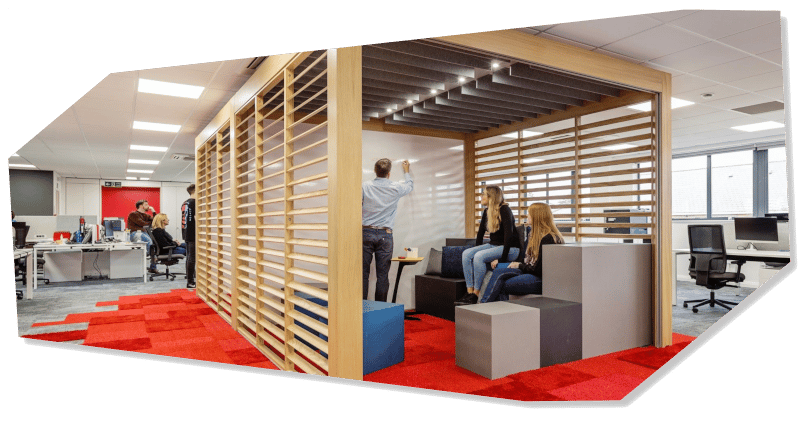All change for the future of work
All of the recent changes in the way people work, from the nature of the work we undertake, to changing attitudes and priorities, evolving technologies, the need to innovate and to mitigate future risks in the light of recent events, mean that the workspace must adapt in order for people and businesses to thrive.
Work is an activity, not a place – and organisations that are able to move away from reliance on static, unresponsive work environments towards a new, more adaptable way of working stand to reap the rewards in terms of productivity, innovation, talent attraction and retention, and business performance.
Traditional office design is increasingly giving way to a host of new modes and models of work, each tailored to different individual and organisational needs. These new paradigms include agile working, activity-based working, hybrid and remote working, and the concept of the ‘destination office.’
What this looks like in reality will vary from one business to the next, with many choosing some combination of all these approaches to best suit their specific needs.
Agile working
It may have been around for quite a while now, but the concept of agile working is more relevant today than ever. Agile working focuses on providing flexibility and choice to individuals and teams to curate the ideal work environment for the task at hand. It involves a combination of physical spaces and technology overlay to provide versatile work settings with adaptability at their heart.
Modular furniture and work settings are a regular feature of an agile work environment, with the ability to rearrange a space to suit different tasks. There is also a focus on technology, allowing people to collaborate more effectively both in person and from remote locations, whether that be home working, working at client sites or other locations.
There is some overlap between the concept of agile and activity-based working, but with agile working the focus in particularly on flexibility, on combining in-person and location-independent working, and on enabling teams to collaborate more effectively, removing silos and barriers between different departments and job functions.
Hybrid working
The last few years have seen a meteoric rise in hybrid working. The pandemic forced many companies to adopt a system of at least partial remote working, with individuals and teams taking turns to work on- and off-site on different days. Many were surprised by how easy the transition was.
The discovery that much knowledge work can be performed just as effectively from home, from a café, or while on the train, provides greater freedom to individuals, while also providing an opportunity for companies to rationalise their office space requirements, with many handing back part of their floorplate to the landlord, or subletting it to turn a profit.
Location-independent working reduces lost time from commuting, as well as opening up opportunities to work during the hours that best mesh with a worker’s non-work commitments. Giving workers more control over where (and when) they work boosts job satisfaction and engagement, while also improving productivity and performance.
The hybrid workspace offers a mixture of flexible settings on-site, such as hot desks, collaboration areas and quiet booths, while also providing the technology to enable workers to access their virtual desktops, complete with all appropriate software, files and communication tools, from any location. This also means providing an in-office technology overlay that enables workers on-site to communicate and collaborate freely with those working remotely, including video conferencing rooms, virtual collaboration tools and at-desk video calling.
Activity-based working
Activity-based working focuses on providing a range of work settings, each tailored to the specific requirements of different roles and tasks. The emphasis is on providing an environment where workers can choose the space and setting best suited to the task at hand, with the ability to move seamlessly between different settings. This drives improved productivity and performance, by providing the optimal environment for each type of task, removing barriers to productivity.
An activity-based workspace will include a variety of spaces, from individual desks to meeting rooms, huddle booths, project and collaboration spaces, video conferencing and digital collaboration tools, quiet rooms and breakout spaces. The exact ratio and configuration of these different kinds of spaces will depend on the needs of the business, and may also include specialist spaces that include specific equipment and settings.
Additionally, the space may be divided into different zones for different teams, with teams who interact frequently placed alongside one another.
Some more examples of activity-based work settings include:
- Focus spots – for individual working, quiet zones to promote concentration
- Collaboration hubs – team areas with seating hubs and portable presentation boards, ideal for brainstorming
- Social zones – comfortable seating, informal meeting tables
- Amenities – cafeterias, restrooms
- Wellbeing spaces – sleep pods, cafeterias, mini gym
- Conference rooms
- Hotdesking spaces – non-allocated desks dotted around the office, or in a central hotdesking area
- Meeting booths – private or open, consider modular partitions for adaptability to various situations
- Presentation rooms
- Learning hubs
The destination office
As well as equipping workers with the tools and technology to work more flexibly, leading businesses have also come to understand the changing role and value of the physical workspace. While it might not be essential for workers to be there every day, workplaces serve a key role in fostering a shared sense of community, identity and purpose that holds organisations together and helps them set the direction of travel and focus for the business.
Most employees don’t want to do away with the office altogether; they see the value of having a dedicated space for key interactions, to check in with colleagues and reconnect with the wider organisation. Work gives us a purpose, goals to strive for, and a sense of belonging. The destination office serves as a hub for defining and reinforcing these values, as well as providing a range of work settings tailored to the specific needs of the organisation’s people and the tasks they undertake.
The destination office contains features that foster in-person communication and collaboration, alongside the usual work settings such as desks, meeting rooms and breakout spaces. Features that particularly pertain to the destination office include boardrooms, ‘town hall’ space, project spaces and collaboration tools and technologies such as smart boards, project walls and digital whiteboards. There is also a focus on amenities such as cafeterias and event/function spaces.
Coworking
Co-working spaces have grown in popularity enormously in recent years. They’ve gone from being a niche option for independent workers and small start-ups, to becoming one of the most desirable workspaces for a breadth of businesses and employees alike.
Having initially appealed to solo entrepreneurs and small-scale start-ups, the idea of co-working is now a widespread solution that larger corporates are getting in on: as flex space to accommodate growing headcounts and new teams; as a way of breaking into new geographies with minimal set-up costs; as a way of connecting with the interesting ventures and talented individuals that occupy these spaces.
Coworking spaces contain a mixture of shared facilities and private spaces. For some users, the ability to hot-desk, to connect and network with peers using the space is of prime importance, and an open plan space with high-end amenities is essential for this. For other teams, having a private space for collaboration and meetings is central, and coworking spaces often emphasise provision of private rooms to accommodate these users. Connectivity and the ability to configure and adapt different work areas are essential requirements for any coworking space.
Traditional
For some businesses, the traditional office is still the best option for them. Traditional office configurations still have much to recommend them. For teams and departments that collaborate closely, having all your people in the same space can facilitate communication and team working.
In some sectors, such as the legal sector, firms work extensively with confidential data and often have to keep paper files, in which case a traditional office has many advantages for data security and accessibility. The traditional office can also serve as a flagship for the brand, with the ability to host client meetings as well as reinforcing a sense of shared community and purpose among workers.
Traditional offices still contain a range of different work settings, from fixed and flexible desking, to meeting rooms, breakout spaces, boardrooms, ‘town hall’ spaces, social spaces and amenities.
Each individual organisation will shape their workspace around a combination of different elements, often combining elements of different approaches to find the optimal space for their specific needs. The key to getting it right is to carefully analyse the needs of the business and its people, and then translate those into a work environment that best supports those needs.
How Office Workspace can help
We can help you to take the first steps on your journey to a more productive, effective and engaging workplace. It’s as simple as having an informal chat with one of our workspace team, to find out a bit more about your business and your drivers for change.
To find out more about how we can help you to innovate the way you work, get in touch by emailing hello@officeworkspace.com or calling +44 (0)20 8039 0000. You can also fill out our online contact form, and we’ll get back to you as soon as possible.

